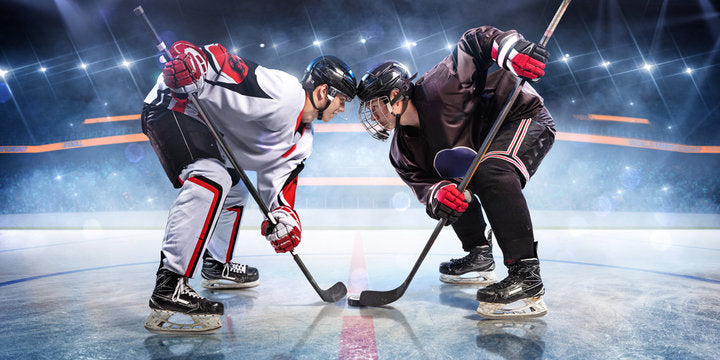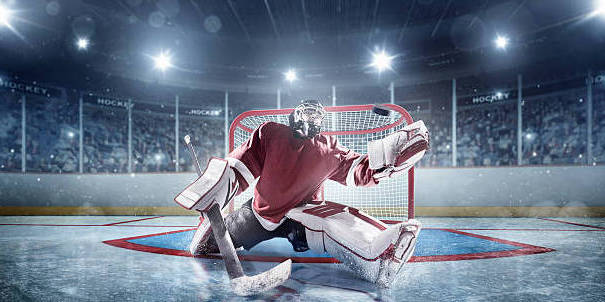Skate Sharpening
Choose Your Radius
Radius of Hollow Explained
We will explore some of the many options available and clear up some of the confusion associated with skate sharpening. The majority of players, over time, have developed a routine when it comes to sharpening. It's a pattern, or habit that players fall into, for example: after two games and a practice, or every four times on the ice or once a week at a specific rink or shop. This approach is comforting for the player, and tends to contribute to the level of confidence in skating and, ultimately in game performance. Others have a less regimented approach and will take whatever is available, wherever they happen to be. Whatever the approach, it is a very personal one and often sticks with a player throughout their playing career and beyond. Many drive miles out of the way to that one shop that does it right or drops the skates off to be processed, then pick them up a couple of hours later or even the next day. But sometimes, a player will break from routine. They didn't have time to stop off at the favorite shop, or a skate suddenly lost an edge or when at a strange arena and knowing the skates need a tune-up. These kinds of situations will lead one to try a different sharpener. And what a surprise when you step onto the ice and the sharpening is not what was expected! Trying to stop, but the skates keep on sliding through the intended stop position or they really dig into the ice and stop too suddenly. This of course is attributed, to bad sharpening and they swear never to get the skates done there again. This experience will further strengthen the conviction to not break routine. But is it really a bad job of skate sharpening? More often than not - NO, but it is indeed different and does not meet the needs or expectations of the player. And just what makes the difference? Often it is the RADIUS - Let me explain: On each skate there are two edges, an inside edge and an outside edge. Between these edges, running the length of the blade is a hollow that is ground out by the wheel of the sharpener. This hollow can be deep or shallow depending on the choice of the operator. The deeper the hollow, the higher the edges and, of course, the more bite they will offer when it comes to starts, stops and turns on the ice. What controls the depth of this hollow is the RADIUS of the 'dressing' (the preparation) to the grinding wheel. A small radius will mean a deep hollow. Conversely, a large radius will result in a shallow hollow. Different settings are available and are offered at some shops by special names such as:
A, B,. . . D cuts or 1, 2. . . . 5 cuts without the explanation of this RADIUS stuff. Keep in mind though, that a certain special B cut at one shop is not necessarily the same as a B cut at another. You can take the mystery out of it all if you learn the radius of the hollow that best suits you, your style of hockey and skating skill. You will then be armed with enough information to specifically ask for your skate sharpening by the proper RADIUS. Here is what I mean - Radius cuts (ROH) range from about 3/8" to +1"; with several graduations in between. This doesn't seem like much on a ruler but to the edge of a skate it means a lot. And to the player, it is the difference between a surprise and expectation. The smaller 3/8" radius is an extremely aggressive cut because of the very high edges that result. The larger +3/4" results in a fairly flat cut that is sometimes used by old time goalies and figure skaters. The average radius applied in general by many shops for players seems to be at the 1/2" or 5/8" mark. More or less edge can be asked for but, as a suggestion, start with this setting. If you change, get to know what that new setting is, and ask for it at every sharpening. Then, as your skills change or body weight increases or decreases, adjustments can be made knowledgeably and surprises avoided.

All About Hollow Radius
Now we should understand some of the principals - theory of skate sharpening. While it has been described as a groove, a hollow grind, or a ground radius, you could refer to it to your skate sharpener as follows:
- I normally skate on a 5/8 inch radius hollow
- sharpen my skates to a 1/2 inch hollow please
- I would like a 3/4 inch radius ground onto my blades please
By grinding a hollow/radius into your skate blade you are making your edges sharp and depending upon the radius you choose, you are also making your edges more (or less) pronounced in the shape at the tips.
Remembering some school math, you may recall that a 1inch diameter circle will have a 1/2 inch radius.
A sharpening attendant can easily dress (shape) the face of the grinding wheel to the curvature shape of
any radii between 3/8 and 1 or +1 inch.
By dressing the radius of choice onto the grinding wheel, it will be transferred to the skate blade by grinding.
WHAT RADIUS IS BEST? THE MEANING OF 'SHARP'
Choosing a radius can be as simple or as complex as you choose to make it. There are many 'experts' who disagree on skate sharpening. There are also some sharpening outfits that have developed sharpening gimmicks, primarily as marketing techniques to attract customers. You should also be able to form opinions on your own. To begin, let's look at what different radii look like on the bottom of a blade. After a skate has been ground it will have sharp edges regardless of how big or small the radius is. Keep in mind the long speed skating blades are honed flat or with almost no radius (hollow). They are looking for maximum glide. While they are careful in the turns, don't ever doubt that these blade edges are not sharp! The real questions to ask yourself are:
- Is there enough edge or bite into the ice for me ?
- Is there too much edge or bite for me ?
If immediately upon use you feel the skate is not sharp enough, you may really mean the skate does not have enough edge (bite) to suit your skating style.


How much edge you can tolerate is affected by four main variables.
These are: (1) weight, (2) skating assignment, (3) skill level and (4) ice temperature.The following is general purpose in nature and you must find the right setting for your needs.
In no case should a radius smaller than 3/8 inch be needed, this having too much edge for anyone, and may even create a safety hazard not only for the skater but also for the sharpening attendant while dressing the grinding wheel to such a tight radius.
1 - WEIGHT
An extremely light skater can tolerate a very small radius (deep hollow - lots of edge). They do not have much weight to bear on the ice. Note: beginner level skaters can learn most skills (particularly the hockey stop) easier by having skates with a larger radius (less edge).
As they progress in skill, the radius is decreased back to a normal level. A heavy skater trying to skate on a small radius (too much edge) will bite into the ice so hard that they will have trouble stopping without chatter or going over the top of their skates. They will also loose glide quickly to excess friction. On the other hand, they will be able to hold a very tight turn!
Professionals can skate on smaller radii as they have the combination of leg/ankle strength and skating skills to get away with it.
Skating on too small a radius feels like skating on soft ice. While 3/8 inch radius edges are more pronounced than 5/8, they are also more fragile and less durable. A general purpose chart (rule of thumb) for radius by weight for average skating skill is as follows:
Very Light (>100lbs): 1/2"
Average (100-160lbs): 9/16"-5/8"
Heavy (<160lbs): 5/8"+
Goalie: 3/8"-1"
2 - SKATING ASSIGNMENT
1/2" and 5/8" seems to be a very common radius for players through high school. Forwards generally prefer smaller radius than defensemen of the similar weights. Years ago, goalies generally prefered larger radii or flatter cuts so that they can kick out
without catching an edge; although recent trends reveal that a deeper radius is much more common among butterfly style goalies.
Gretzky: 1/2" Coffee: 1" to 2" Messier: 1" . Pronger: 7/8" Sakic: 5/8" Iginla: 1/2" Matthews: 5/8" Crosby: 11/16"
3 - SKILL LEVEL
As your skating skill level changes, experiment a little with a different radius. Find the one that works best for you.
4 - ICE TEMPERATURE
Most rink managers shoot for an ice temperature of approximately 25 degrees fahrenheit.
A temperature of 17 to 23 degrees is considered 'hard hockey ice', 25 to 26 degrees is considered good figure skate ice.
A slightly smaller radius may be required on colder/ harder ice.
Achieve Even Edges
Even edges are crucial to the performance of your skating. If your skates have uneven edges, the “higher” edge will seem way too sharp, while the “lower edge” will seem way too dull. You may have experienced this before or can imagine how difficult it would be to make even simple maneuvers on skates with uneven edges. The average piece of paper is about .004″ thick. While that might not seem like a lot, any decent skater will easily be able to notice .004″ of error when skating.

Maximize Skating Speed
The “finish” of your skate blade refers to how smooth and clean the bottom of your skate blade is after sharpening, which directly affects glide and speed. A blade with a poor finish (chatter marks, ripples, etc.) is actually causing more friction with the ice during gliding than if the bottom of the blade is completely smooth and clean. To maximize glide, it is important that you apply a smooth and clean finish to the bottom of your blade during the final pass of your sharpening.


Most information above was originally presented by Wissota Mfg, at www.wissota.com


